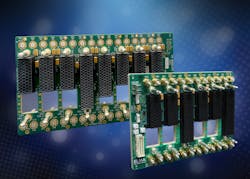Webcast update on Sensor Open Systems Architecture (SOSA) open-systems standard for embedded computing
NASHUA, N.H. – Government and industry partners are working together to ensure that technology is vendor-neutral and easily upgradable thanks the Sensor Open Systems Architecture (SOSA) Consortium.
Experts Patrick Collier, the SOSA and systems engineer for Aspen Consulting Group in Manasquan, N.J., and Susan Harper, the manager of standards and certifications at The Open Group in San Francisco, informed the military embedded computing community that the first version of the SOSA rules could be released as soon as this summer.
These experts made their comments during a webcast hosted by Military & Aerospace Electronics on March 18.
An on-demand version of the event, sponsored by Kontron America Inc. in San Diego; Pentek Inc. in Upper Saddle River, N.J.; and Elma Electronic Inc. in Fremont, Calif., can be viewed online at https://www.militaryaerospace.com/home/webinar/14198305/understanding-conformance-to-the-sosa-technical-standard.
Related: SOSA open-systems standard gains momentum for embedded computing
The emerging SOSA open-systems standard -- overseen by The Open Group -- aims to enable military embedded systems designers to create new systems and make significant upgrades to existing systems much quicker than today's technologies allow.
The high-level goals of SOSA include openness and being platform- and vendor-agnostic while being aligned with Modular Open Systems Approach (MOSA) using standardized software and hardware. The consortium aims to leverage existing and emerging open standards and align with U.S. Department of Defense (DOD) service objectives. Finally, SOSA aims to keep technology affordable and adaptable.
Collier explained that the SOSA standard applies to each module of a system rather than the entire embedded computing system itself.
"The degree to which a system or element is composed of individually distinct physical and functional units that are loosely coupled with well-defined interface boundaries," Collier says.
"In the context of the SOSA architecture, this quality attribute enforces the establishment of well-defined, well-understood, standardized system modules that can be created and tested individually for function and conformance."
Collier notes the modules are intended to be used as "building blocks" that can be put together to build the embedded computing system right for the application the customer is asking for.
The Open Group's Harper explains that standards are needed to provide an agreed way to drive innovation and productivity while increasing effectiveness and repeatability. In addition, SOSA standards will ensure the quality of the modules delivered and that the modules are in legal compliance.
"We believe in openness, consensus, timely and deterministic process, public availability of published specifications. We make sure there's no legal impediment to implementation or adoption. We believe in confidentiality and executable standards," Harper says.
The SOSA standard is being drafted by a diverse group of experts in the consortium that Harper notes are competitors in business but are partners inside and The Open Group provides unbiased arbitration.
"The biggest thing is to prove the standard works," says Harper. "You can say, 'O.K., I built the product and it worked, but there's no way to verify it conformed to the standard unless there's a certification process."
Harper informed that get the "green light" as a SOSA-certified, each module will have to be verified by an accredited authority outside the company as "self verification" is not allowed by The Open Group. In addition, certification will be done by The Open Group to "verify the verification."
The cost for certification has yet to be determined by the SOSA consortium. Verification, on the other hand, is a cost that will have to be determined by the company and the verifying authority.
Related: SOSA draft industry standard picking up steam
"There's no way for us to tell how much verification is going to cost," Harper says. "Some suppliers have an agreement with the verification authority."
Once the certification and verification is complete, the vendor will result in having a "certified SOSA sensor component."
Each individual building block is certified, but the system itself doesn't have to go through certification," Collier says.
According to Harper, once the SOSA 1.0 rule set is released, The Open Group will no longer allow vendors to say their system is "SOSA aligned."
Related: The brave new world of embedded computing backplanes and chassis
While The Open Group is targeting a release of SOSA 1.0 this July, the consortium is still encouraging the military embedded computing industry to join and lend their expertise.
We're trying really hard to get it right on version one, but there's going to be changes. Please join," Harper closed.
For more information, or to join the consortium, please visit https://www.opengroup.org/sosa.
About the Author
Jamie Whitney
Senior Editor
Jamie Whitney joined the staff of Military & Aerospace Electronics in 2018 and oversees editorial content and produces news and features for Military & Aerospace Electronics, attends industry events, produces Webcasts, and oversees print production of Military & Aerospace Electronics.
